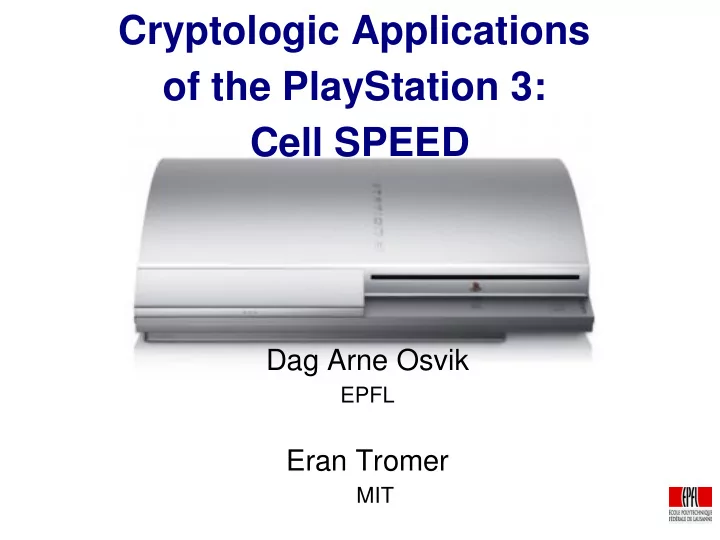

Cryptologic Applications of the PlayStation 3: Cell SPEED Dag Arne Osvik EPFL Eran Tromer MIT
Cell Broadband Engine 1 PowerPC core − Based on the PowerPC 970 − 128-bit AltiVec/VMX SIMD unit Currently up to 8 “synergistic processors” Runs at ~3.2 GHz A Core2 core has three 128-bit SIMD units with just 16 registers.
Running DES on the Cell Bitsliced implementation of DES − 128-way parallelism per SPU − S-boxes optimized for SPU instruction set 4 Gbit/sec = 2 26 blocks/sec per SPU 32 Gbit/sec per Cell chip Can be used as a cryptographic accelerator (ECB, CTR, many CBC streams)
Breaking DES on the Cell Reduce the DES encryption from 16 rounds to the equivalent of ~9.5 rounds, by shortcircuit evaluation and early aborts. Performance: − 108M=2 26.69 keys/sec per SPU − 864M=2 29.69 keys/sec per Cell chip
Comparison to FPGA Expected time to break: COPACOBANA − ~9 days − €8,980 − A year to build 52 PlayStation 3 consoles − ~9 days − €19,500 (at US$500 each) − Off-the-shelf Divide by two if you get E K ( X ) and E K ( X ).
DreamHack 2004 LAN Party DreamHack 2004 LAN Party 5852 connected computers 5852 connected computers Under 1 hour for a real-time DES break. Under 1 hour for a real-time DES break.
Synergistic Processing Unit 256KB of fast local memory 128-bit, 128-register SIMD Two pipelines In-order execution Explicit DMA to RAM or other SPUs
SPU memory Single-ported 6-cycle load-to-use latency Read or write 16 or 128 bytes each cycle DMA & instruction fetch use 128-byte interface Prioritized: DMA > load/store > instruction fetch
SPU registers 128 registers Up to 77 register parameters and return values according to calling convention
SPU instruction set RISC (similar to PowerPC) Fixed 32-bit size Always aligned on 4-byte boundary Most operations are SIMD
SPU pipelines and latencies
SPU limitations Fetches 8-byte aligned pairs of instructions − Dual issue happens only if first is even-pipe instruction and and second is odd-pipe instruction Only 16x16->32 integer multiplication No hardware branch prediction
Special SPU instructions select bits shuffle bytes gather bits form select mask carry/borrow generate add/sub extended sum bytes or across generate controls for count leading zeros insertion count ones in bytes
64-bit addition 2-way SIMD: 4-way SIMD: − carry generate − carry generate − add − add − shuffle bytes − add extended − add
64-bit rotate 2-way SIMD: 4-way SIMD: − rotate words − 2 * rotate words − shuffle bytes − 2 * select bits − select bits
selb Bitwise version of “a = b ? c : d” Also known as a multiplexer (mux) Very useful for bitslice computations − DES S-box average less than 40 instructions − Matthew Kwan: 51, without using selb
Comparison to Core2 for bitslice CPU SPU Core2 Registers 128 16 Register width 128 128 Registers/instruction 3 2 Boolean operations *+select and, or, xor, andn Instruction parallelism 1 3 Cores per chip 6-8 2-4
shufb Concatenate two input registers to form a 32- byte lookup table Each byte in the third register selects either a constant value (0x00/0x80/0xFF) or a location in the lookup table => 16 table lookups per cycle
AES Table lookups in registers 5->8 bit lookups directly supported by shufb For the remaining 3 input bits we need to isolate and replicate them, and then use selb to select between 8 different shufb outputs High latency, but also high throughput with 4- way interleaving
Cache attack resistance SPUs currently immune − no address-dependent variability in memory access Architecture allows cache in SPU In-register lookups should be future-proof
Branch prediction Calculate branch address Give branch target hint ... Branch without penalty
Optimization summary Do vector (SIMD) processing Large number of registers allows interleaving several computations, hiding latencies Balance pipeline usage Pre-compute branches in time to give hint For very memory-intensive code, ensure instruction fetch by using hbrp
Running MD5 on the Cell 32-bit addition and rotation, boolean functions − Directly supported with 4-way SIMD − Bitslice is slow: 128 adds require 94 instructions Many streams in parallel hide latencies Calculated compression function performance: Up to 15.6 Gbit/s per SPU
Running AES on the Cell > 2.1 Gbit/s per SPU (~3.8 GHz Pentium 4) ~17 Gbit/s for full Cell, almost 13 Gbit/s for PS3 CBC implementation only a little slower. Bitslice would be very interesting
Other cryptographic applications for the Cell Broadband Engine Limited by SPU microarchitecture and memory Good match for low-memory, straight-path computation over small operands Some promising applications: − Stream cipher cryptanalysis − Sieving for the Number Field Sieve − Hash collisions
The future of the Cell More SPUs on a chip Internal cache in SPUs Fast double precision float Different size of local memory? New instructions?
Recommend
More recommend